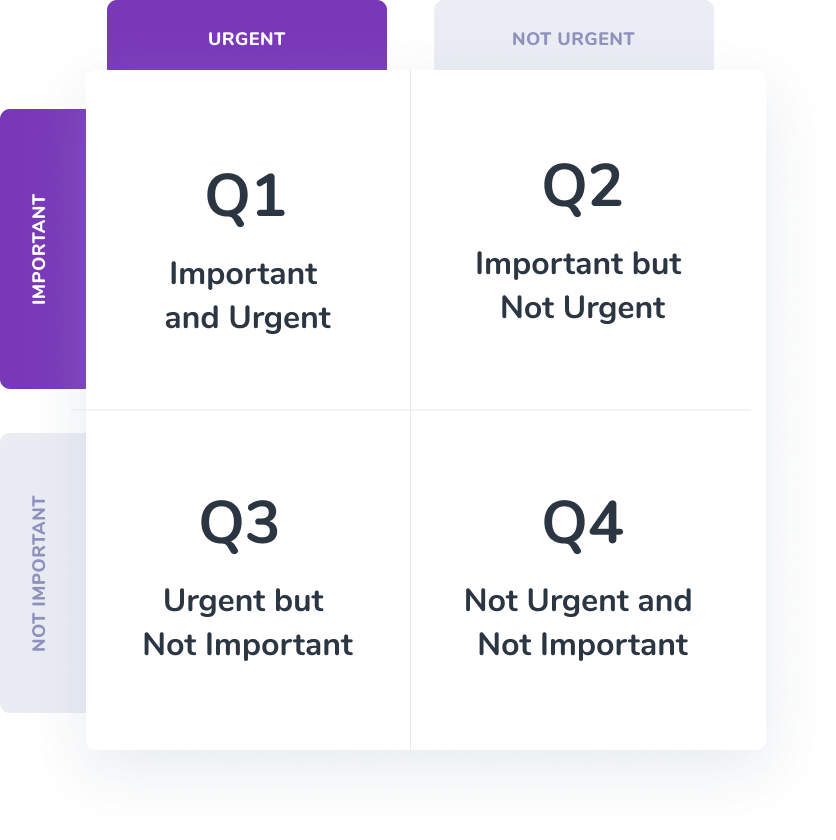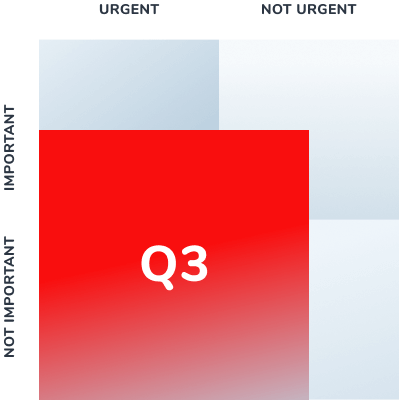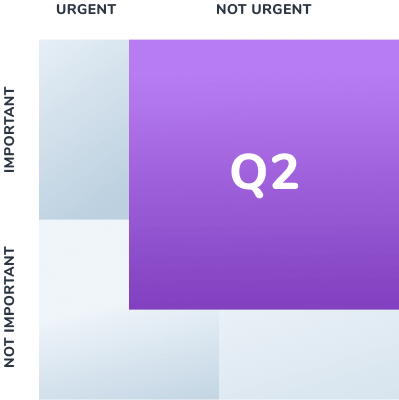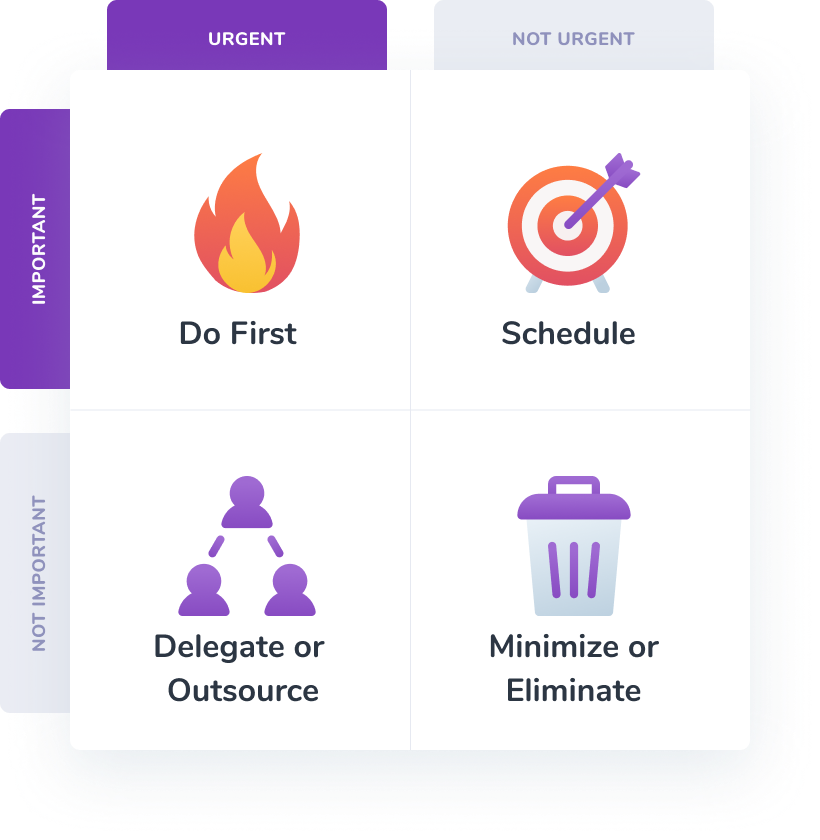Welcome to Lesson 2: Prioritization for Transcript Professionals! Today, we’ll learn how to use a simple tool that keeps us focused on our most important tasks: The Eisenhower Matrix

What do you, Oprah Winfrey, and President Dwight D. Eisenhower have in common?
You all only have 24 hours in a day.
Some people are simply more productive than others.
Their productivity secret? It’s simple: Better prioritization.
People who get more done — like CEO of Cover Crow Inc. AND full-time CSR, Cassandra Caldarella — prioritize their most important tasks while delegating or eliminating the rest.
In Lesson 1, you learned how SMART goals put you on the path to success.
In this lesson, we’re going to show you a powerful tool that helps you prioritize your MOST IMPORTANT tasks and remove distractions from your day.
With this tool, you’ll finally be able to focus on your target and hit your goal every time.
Introducing: The Eisenhower Matrix.
The Eisenhower Matrix
“I have two kinds of problems: the urgent and the important. The urgent is seldom important, and the important is seldom urgent.” – President Dwight D. Eisenhower
The Eisenhower Matrix is a simple graph that helps us prioritize our time. It splits our activities into four quadrants:

- Quadrant 1: Important and Urgent
- Quadrant 2: Important but NOT Urgent
- Quadrant 3: Urgent but NOT Important
- Quadrant 4: Not Urgent and Not Important
Urgent tasks are things that must be done as soon as possible. Important tasks contribute directly to your goals and are things only YOU can get done.
Here’s where many of us get tripped up:
Instead of focusing on the most important things, we get distracted by urgent tasks.
When We Prioritize the Urgent, We Don’t Have Time for What’s Truly Important
How do you decide what to work on each day?
If you’re like many of us, your day is dominated by the most urgent activities.
But here is the truth: Most urgent things are not important (at least, not for YOU to do).
These urgent but not important (for you) activities belong in Quadrant 3:

For most of us, tasks in Quadrant 3 (Urgent but not important) dominate our time.
Q3 activities give you the illusion of productivity because they keep you busy. In reality, they take time away from accomplishing your most important work.
Examples of Quadrant 3 activities:
- Scoping and proofreading your own transcripts. (Important Note: This doesn’t mean that job is not important. It means it’s not important FOR YOU to be the one that does it.)
- Meetings that could have been emails
- Household chores that family help with (like making dinner, unloading the dishwasher)
- Checking your email inbox and text messages
Many Q3 tasks are OPPs: Other People’s Priorities. If someone comes to you with an urgent task, which is important to THEM, we feel obligated to help, but doing so derails our priorities.
This may make you friends, but they doesn’t help you reach your goals.
Sidebar: Delegating Scoping and Proofreading
- But wait a minute,” you say, “Scoping and proofreading are SUPER important! It’s an essential part of producing high-quality, verbatim transcripts.”
You’re 100% correct. But as a court reporter, you make your money on the steno machine.
? Every hour you spend at home editing and proofreading, your profit-per-hour drastically decreases.
These are hours you could be taking another job or doing something else incredibly productive that only YOU can do.
That’s why we encourage every court reporter to collaborate with scopists and proofreaders. We frequently hear reporters think they save money if they do it themselves. On the contrary, most reporters actually lose money because they forgo work opportunities to catch up on pages.
So it’s a lose-lose for your productivity and your wallet. That’s why learning to delegate tasks in Quadrant 3 is so imperative.
Prioritize the Important, NOT the Urgent
When Quadrant 3 tasks dominate our day, we’re far less likely to accomplish our important tasks. It’s like aiming your arrow at the distractions around you, instead of the target straight ahead.
? To maximize productivity, prioritize Quadrant 2: Important, but not urgent activities that help us reach our long-term goals.

To maximize productivity, prioritize Quadrant 2: Important but not urgent activities.
Quadrant 2 activities are the unsung heroes of productivity. These tasks are extremely important for our long-term success, but they are rarely urgent.
For example:
? ¯ Speed Practice & Dictionary Building
? ¯ Financial Planning
? ¯ Quality time with family
? ¯ Learning new business management skills
? ¯ Exercise
Because they aren’t urgent, Q2 tasks get put on the back burner. Urgent tasks (both important and NOT important) take priority if we’re not deliberate with our time.
To feel more productive and reach our goals, prioritize Quadrant 2 (Important but not urgent) activities over Quadrant 3 (urgent but not important).
Try to spend as much of your time in Q2 as possible. Here’s an exercise to get you started:
Exercise: Prioritize Tasks as Come Up
Stenovate has another freebie for you! Click the link and follow the instructions to save a copy of Stenovate’s Eisenhower Matrix for yourself! As to-dos arise in your day, decide if the task is urgent or important and add it to the appropriate quadrant. Focus on spending more time in Quadrant 2 and less time in Quadrants 3 and 4.
? Free download: Eisenhower spreadsheet matrix

Quadrant 1: Do First
Quadrant 1 activities — things that are both urgent and truly important — should be done first. They are important to your long-term goals and something only you can do. When planning your day, make Q1 tasks your top priority.
Examples:
?Agency asking for an immediate expedite
?Your child is hurt/crying
?Kitchen sink pipe breaks and is flooding the floor
Quadrant 2: Schedule
Quadrant 2 tasks are the most important things we can do for hitting our target goals. However, in a world of distractions and urgency, we rarely make time for them.
? Schedule Quadrant 2 activities on your calendar to make sure you save time for them.
Block off time dedicated to these all-important tasks, and don’t let urgent and non-important things get in the way.
Examples:
?… Exercise
?… Family time
?… Communicating w/ scopists and proofreaders, checking on job status, etc.
?… Taking a depo/speed building practice
Quadrant 3: Delegate or Outsource
Quadrant 3 tasks tend to dominate our time, but they don’t help us accomplish our goals.
? The key to managing these Q3 tasks is to delegate and outsource.
Delegating and outsourcing allow you to focus on the things you CAN’T delegate, like speed practice, taking depositions, or going to your grandchild’s soccer game.
If you’re a court reporter, outsource scoping and proofreading. There are incredible, full-time scopists and proofreaders ready to help you grow your business. (Trust us, we know!)
Examples:
? Paying the electricity bill (covered by your spouse)
? Unloading the dishwasher and matching socks (covered by your kiddos)
? SCOPING & PROOFING (which takes up 50% of your working hours and can be delegated to scopists and proofreaders)
? Walking the dog (hire a dog walker)
Quadrant 4: Minimize or Eliminate
Activities that are not urgent and not important should be your last priority. Q4 tasks include time-wasting activities as well as frivolous, work-related tasks.
Examples:
? Scrolling through Facebook, Instagram, Twitter, etc.
? Binge-watching Netflix
? Non-important emails, calls, and texts
We’re not saying you should NEVER do fun Quadrant 4 activities. It’s good to indulge a bit. But most of us spend a little too much time on things that don’t move us towards our goals.
? Make sure Q4 activities are the last thing that ends up on your calendar.
Also, don’t confuse Q4 time-wasters with important Q2 activities like family time, which could be planned or spontaneous. Family time is one of the most important things, and there’s no outsourcing or delegating it!
Take back your time with better prioritization
If your goal is to be more productive, you must prioritize the things that matter most.
The Eisenhower Matrix is a simple tool that helps you identify your most important tasks (Q1 and Q2), minimize distractions (Q4), and delegate the rest (Q3).
In the next lesson, we’ll show you how to translate your priorities to your calendar and schedule your Most. Productive. Day. Ever!
In the meantime, download the Eisenhower Matrix spreadsheet and start prioritizing your time.
If you’re looking for even more ways to power up your transcript business, try Stenovate FREE for 30 days.
⬅️ Go to Lesson 1 | Go to Lesson 3

